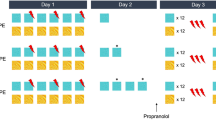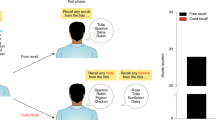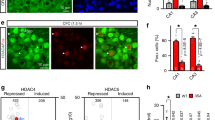Abstract
Targeting epigenetic mechanisms during initial learning or memory retrieval can lead to persistent memory. Retrieval induces plasticity that may result in reconsolidation of the original memory, in which critical molecular events are needed to stabilize the memory, or extinction, in which new learning during the retrieval trial creates an additional memory that reflects the changed environmental contingencies. A canonical feature of extinction is that the original response is temporarily suppressed, but returns under various conditions. These characteristics have defined whether a given manipulation alters extinction (when persistence does not occur) or reconsolidation (when persistence does occur). A problem arises with these behavioral definitions when considering the potential for persistent memory of extinction. Recent studies have found that epigenetic modulation of memory processes leads to surprisingly robust and persistent extinction. We discuss evidence from behavioral epigenetic approaches that forces a re-evaluation of widely used behavioral definitions of extinction and reconsolidation.
This is a preview of subscription content, access via your institution
Access options
Subscribe to this journal
Receive 12 print issues and online access
$209.00 per year
only $17.42 per issue
Buy this article
- Purchase on Springer Link
- Instant access to full article PDF
Prices may be subject to local taxes which are calculated during checkout


Similar content being viewed by others
References
Maren, S. Seeking a spotless mind: extinction, deconsolidation and erasure of fear memory. Neuron 70, 830–845 (2011).
Quirk, G.J. et al. Erasing fear memories with extinction training. J. Neurosci. 30, 14993–14997 (2010).
Torregrossa, M.M. & Taylor, J.R. Learning to forget: manipulating extinction and reconsolidation processes to treat addiction. Psychopharmacology (Berl). published online, doi:10.1007/s00213-012-2750-9 (26 May 2012).
Alberini, C.M. The role of protein synthesis during the labile phases of memory: revisiting the skepticism. Neurobiol. Learn. Mem. 89, 234–246 (2008).
Davis, M., Myers, K.M., Chhatwal, J. & Ressler, K.J. Pharmacological treatments that facilitate extinction of fear: relevance to psychotherapy. NeuroRx 3, 82–96 (2006).
McGaugh, J.L. & Roozendaal, B. Drug enhancement of memory consolidation: historical perspective and neurobiological implications. Psychopharmacology (Berl.) 202, 3–14 (2009).
Qi, Z. & Gold, P.E. Intrahippocampal infusions of anisomycin produce amnesia: contribution of increased release of norepinephrine, dopamine and acetylcholine. Learn. Mem. 16, 308–314 (2009).
Delamater, A.R. Issues in the extinction of specific stimulus-outcome associations in Pavlovian conditioning. Behav. Processes 90, 9–19 (2012).
Lattal, K.M. & Lattal, K.A. Facets of Pavlovian and operant extinction. Behav. Processes 90, 1–8 (2012).
Radulovic, J. & Tronson, N.C. Molecular specificity of multiple hippocampal processes governing fear extinction. Rev. Neurosci. 21, 1–17 (2010).
Stafford, J.M. & Lattal, K.M. Is an epigenetic switch the key to persistent extinction? Neurobiol. Learn. Mem. 96, 35–40 (2011).
Rescorla, R.A. Spontaneous recovery. Learn. Mem. 11, 501–509 (2004).
Pavlov, I.P. Conditioned Reflexes: an Investigation of the Physiological Activity of the Cerebral Cortex (Oxford University Press, London, 1927).
Brogden, W.J., Lipman, E.A. & Culler, E. The role of incentive in conditioning and extinction. Am. J. Psychol. 51, 109–117 (1938).
Reynolds, G.S. Operant extinction near zero. J. Exp. Anal. Behav. 7, 173–176 (1964).
Rescorla, R.A. & Wagner, A.R. A theory of Pavlovian conditioning: variations in the effectiveness of reinforcement and nonreinforcement. Classical Conditioning II: Current research and Theory (eds. A.H. Black & W.F. Prokasy) 64–99 (Appleton Century Crofts, New York, 1972).
Leung, H.T. & Westbrook, R.F. Spontaneous recovery of extinguished fear responses deepens their extinction: a role for error-correction mechanisms. J. Exp. Psychol. Anim. Behav. Process. 34, 461–474 (2008).
Denniston, J.C., Chang, R.C. & Miller, R.R. Massive extinction treatment attenuates the renewal effect. Learn. Motiv. 34, 68–86 (2003).
Rescorla, R.A. Deepened extinction from compound stimulus presentation. J. Exp. Psychol. Anim. Behav. Process. 32, 135–144 (2006).
Lester, B.M. et al. Behavioral epigenetics. Ann. NY Acad. Sci. 1226, 14–33 (2011).
Katada, S., Imhof, A. & Sassone-Corsi, P. Connecting threads: epigenetics and metabolism. Cell 148, 24–28 (2012).
Tronson, N.C., Corcoran, K.A., Jovasevic, V. & Radulovic, J. Fear conditioning and extinction: emotional states encoded by distinct signaling pathways. Trends Neurosci. 35, 145–155 (2012).
Franklin, T.B., Saab, B.J. & Mansuy, I.M. Neural mechanisms of stress resilience and vulnerability. Neuron 75, 747–761 (2012).
Zovkic, I.B. & Sweatt, J.D. Epigenetic mechanisms in learned fear: implications for PTSD. Neuropsychopharmacology 38, 77–93 (2013).
Day, J.J. & Sweatt, J.D. Epigenetic treatments for cognitive impairments. Neuropsychopharmacology 37, 247–260 (2012).
Jakovcevski, M. & Akbarian, S. Epigenetic mechanisms in neurological disease. Nat. Med. 18, 1194–1204 (2012).
Turner, B.M. Cellular memory and the histone code. Cell 111, 285–291 (2002).
Peixoto, L. & Abel, T. The role of histone acetylation in memory formation and cognitive impairments. Neuropsychopharmacology 38, 62–76 (2013).
Wang, L. et al. Chronic cocaine-induced H3 acetylation and transcriptional activation of CaMKIIalpha in the nucleus accumbens is critical for motivation for drug reinforcement. Neuropsychopharmacology 35, 913–928 (2010).
Kilgore, M. et al. Inhibitors of class 1 histone deacetylases reverse contextual memory deficits in a mouse model of Alzheimer′s disease. Neuropsychopharmacology 35, 870–880 (2010).
Stefanko, D.P., Barrett, R.M., Ly, A.R., Reolon, G.K. & Wood, M.A. Modulation of long-term memory for object recognition via HDAC inhibition. Proc. Natl. Acad. Sci. USA 106, 9447–9452 (2009).
McQuown, S.C. et al. HDAC3 is a critical negative regulator of long-term memory formation. J. Neurosci. 31, 764–774 (2011).
Vecsey, C.G. et al. Histone deacetylase inhibitors enhance memory and synaptic plasticity via CREB:CBP-dependent transcriptional activation. J. Neurosci. 27, 6128–6140 (2007).
Lesburguères, E. et al. Early tagging of cortical networks is required for the formation of enduring associative memory. Science 331, 924–928 (2011).
McQuown, S.C. & Wood, M.A. HDAC3 and the molecular brake pad hypothesis. Neurobiol. Learn. Mem. 96, 27–34 (2011).
Vogel-Ciernia, A. & Wood, M.A. Molecular brake pad hypothesis: pulling off the brakes for emotional memory. Rev. Neurosci. published online, doi:10.1515/revneuro-2012-0050 (24 August 2012).
Lattal, K.M., Barrett, R.M. & Wood, M.A. Systemic or intrahippocampal delivery of histone deacetylase inhibitors facilitates fear extinction. Behav. Neurosci. 121, 1125–1131 (2007).
Bredy, T.W. et al. Histone modifications around individual BDNF gene promoters in prefrontal cortex are associated with extinction of conditioned fear. Learn. Mem. 14, 268–276 (2007).
Malvaez, M., Sanchis-Segura, C., Vo, D., Lattal, K.M. & Wood, M.A. Modulation of chromatin modification facilitates extinction of cocaine-induced conditioned place preference. Biol. Psychiatry 67, 36–43 (2010).
Stafford, J.M., Raybuck, J.D., Ryabinin, A.E. & Lattal, K.M. Increasing histone acetylation in the hippocampus-infralimbic network enhances fear extinction. Biol. Psychiatry 72, 25–33 (2012).
Marek, R. et al. Paradoxical enhancement of fear extinction memory and synaptic plasticity by inhibition of the histone acetyltransferase p300. J. Neurosci. 31, 7486–7491 (2011).
Wei, W. et al. p300/CBP-associated factor selectively regulates the extinction of conditioned fear. J. Neurosci. 32, 11930–11941 (2012).
Bahari-Javan, S. et al. HDAC1 regulates fear extinction in mice. J. Neurosci. 32, 5062–5073 (2012).
Malvaez, M. et al. HDAC3-selective inhibitor enhances extinction of cocaine-seeking behavior in a persistent manner. Proc. Natl. Acad. Sci. USA doi:10.1073/pnas.1213364110 (in the press).
Baker, K.D., McNally, G.P. & Richardson, R. D-cycloserine does not facilitate fear extinction by reducing conditioned stimulus processing or promoting conditioned inhibition to contextual cues. Learn. Mem. 19, 461–469 (2012).
Lee, J.L. Reconsolidation: maintaining memory relevance. Trends Neurosci. 32, 413–420 (2009).
Kramár, E.A. et al. Synaptic evidence for the efficacy of spaced learning. Proc. Natl. Acad. Sci. USA 109, 5121–5126 (2012).
Lynch, G., Kramar, E.A., Babayan, A.H., Rumbaugh, G. & Gall, C.M. Differences between synaptic plasticity thresholds result in new timing rules for maximizing long-term potentiation. Neuropharmacology 64, 27–36 (2013).
Lai, C.S., Franke, T.F. & Gan, W.B. Opposite effects of fear conditioning and extinction on dendritic spine remodeling. Nature 483, 87–91 (2012).
Lahm, A. et al. Unraveling the hidden catalytic activity of vertebrate class IIa histone deacetylases. Proc. Natl. Acad. Sci. USA 104, 17335–17340 (2007).
Acknowledgements
We thank K. Bieszczad and M. Malvaez for helpful comments. Preparation of this manuscript was supported by grants from the US National Institutes of Health (DA018165, DA025922, DA031989, MH077111 and MH081004). The order of authorship was determined by lot.
Author information
Authors and Affiliations
Corresponding authors
Ethics declarations
Competing interests
The authors declare no competing financial interests.
Rights and permissions
About this article
Cite this article
Lattal, K., Wood, M. Epigenetics and persistent memory: implications for reconsolidation and silent extinction beyond the zero. Nat Neurosci 16, 124–129 (2013). https://doi.org/10.1038/nn.3302
Received:
Accepted:
Published:
Issue Date:
DOI: https://doi.org/10.1038/nn.3302
This article is cited by
-
Histone macroH2A1 is a stronger regulator of hippocampal transcription and memory than macroH2A2 in mice
Communications Biology (2022)
-
The Role of DNA Methylation and Activity of Neurotransmitter Receptors in the Mechanisms of Specific Anterograde Amnesia and Memory Recovery
Bulletin of Experimental Biology and Medicine (2022)
-
Memory Reconsolidation after Training of Different Intensities Depends on the Duration of the Reminder Interval
Neuroscience and Behavioral Physiology (2022)
-
[11C]Martinostat PET analysis reveals reduced HDAC I availability in Alzheimer’s disease
Nature Communications (2022)
-
Colon-delivered short-chain fatty acids attenuate the cortisol response to psychosocial stress in healthy men: a randomized, placebo-controlled trial
Neuropsychopharmacology (2020)



